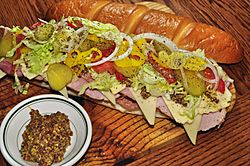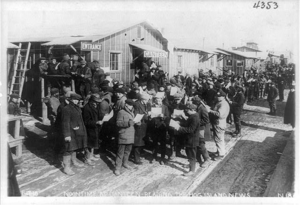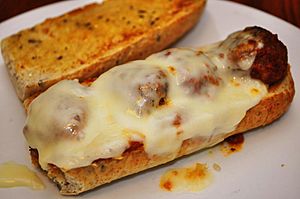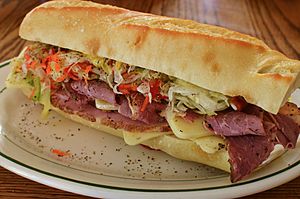Submarine sandwich facts for kids
A submarine sandwich, often called a sub, is a popular type of sandwich. It's made with a long, round bread roll that's cut open lengthwise. Inside, you'll find different meats, cheeses, vegetables, and sauces. You can eat subs cold or hot. This tasty sandwich has many different names depending on where you are.
The names "submarine" and "sub" are used almost everywhere. But many other names are popular in the northeastern part of the United States.
Contents
The History of the Submarine Sandwich
The idea for the Italian sandwich, which is what a sub often is, started in Italian American communities. This happened in the northeastern United States between the late 1800s and mid-1900s.
This type of sandwich became very popular. It spread from states like Connecticut, Pennsylvania, and New York. Now, you can find it in most parts of the United States and Canada. Thanks to large restaurant chains, subs are now enjoyed all over the world. Experts have found at least thirteen different names for the submarine sandwich in the U.S.
Why is it Called a Submarine?
The name "submarine" or "sub" comes from how the long roll looks like a submarine. This name is used widely in the U.S. and Canada.
Some people think the name started in New London, Connecticut, during World War II. This city has a big U.S. Navy submarine base. However, old ads from 1940 in Wilmington, Delaware, show the name was used even before the U.S. joined the war.
One story says that Dominic Conti (1874–1954) brought the submarine sandwich to the U.S. He was an Italian immigrant who came to New York around 1895. In 1910, he opened his grocery store in Paterson, New Jersey. He sold traditional Italian sandwiches there.
His granddaughter said that he named the sandwich after seeing the Fenian Ram submarine in a museum in 1928. The sandwiches were made with a long crusty roll. They were filled with cold meats, lettuce, tomatoes, peppers, onions, oil, and spices. He always started and ended with a layer of cheese. This helped keep the bread from getting soggy.
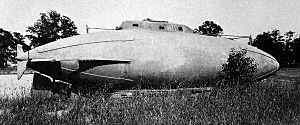
What is a Hoagie?
The name hoagie started in the Philadelphia area. In 1953, a newspaper reported that Italian workers at a shipyard called Hog Island made the sandwich. This was during World War I. They put meats, cheeses, and lettuce between two slices of bread. People started calling it the "Hog Island" sandwich. This name was shortened to "Hoggies," and then "hoagie."
Another idea for the name hoagie comes from a famous musician named Hoagy Carmichael. But the word was used before he became well-known. So, this idea is probably not true.
A different story says that street sellers in Philadelphia created the hoagie. They were called "hokey-pokey men." They sold salads, meats, and buns. When a famous play called H.M.S. Pinafore came to Philadelphia in 1879, bakeries made a long loaf of bread called the pinafore. The "hokey-pokey men" would slice this bread, fill it, and sell the first "hoagie."
Another idea is that the word hoagie came from Italian immigrants in South Philadelphia. When someone was very poor, they were "on the hoke." Deli owners would give away leftover cheese and meat scraps in an Italian bread roll. This roll was called a "hokie," but the immigrants said "hoagie."
After World War II, many different spellings of the word were used in Philadelphia. By the 1940s, "hoagie" became the most common spelling. By 1955, restaurants in the area were all using the term. Hoagies started appearing in Pittsburgh in 1961.
Former Philadelphia mayor Ed Rendell said the hoagie was the "Official Sandwich of Philadelphia." Some people say the hoagie actually started in Chester, Pennsylvania. A deli owner there claims her mother created the hoagie in 1925.
What is a Hero?
The name hero is used in New York City. It was first recorded in 1937. Some people think a food writer named Clementine Paddleford came up with the name. But there isn't strong proof for this.
The name hero is still the main term in New York City for most sandwiches on a long roll. These sandwiches usually have an Italian flavor. Pizzerias often sell eggplant parmigiana, chicken parmigiana, and meatball heros. These are all served with sauce.
What is a Grinder?
In New England, a common name for this sandwich is grinder. There are a few ideas about where this name came from. One idea is that it came from Italian American dock workers, who liked the sandwich. Another idea is that it was called a grinder because the bread's hard crust needed a lot of chewing.
In Pennsylvania, New York, and parts of New England, a grinder usually means a hot submarine sandwich. Examples include meatball or sausage subs. A cold sandwich, like one with cold cuts, is usually just called a "sub." In Philadelphia, a "grinder" can also be any hoagie that is toasted in the oven.
What is a Wedge?
The term wedge is used in some counties north of New York City, like Dutchess and Westchester in New York, and Fairfield in Connecticut.
Some people think the name wedge comes from how the sandwich is cut in half diagonally, making two "wedges." Or it could be because the fillings are "wedged" in between the bread. Another idea is that "wedge" is just a short way of saying "sandwich." This name might have started with an Italian deli owner in Yonkers, New York.
What is a Spukie?
The name spukie (or "spuckie") is only used in Boston. It comes from the Italian word spuccadella, which means "long roll." This word isn't usually found in Italian dictionaries. This might mean it's a special word from a certain part of Italy, or it was made up by Italian Americans in Boston. You often hear "spukie" in parts of Dorchester and South Boston. Some bakeries in Boston's North End sell homemade spuccadellas.
Other Names for Submarine Sandwiches
- Blimpie (looks like a blimp) — This name comes from the restaurant chain Blimpie, which started in Hoboken, New Jersey.
- Gatsby — A type of sandwich found in Cape Town, South Africa.
- Po' boy — A popular sandwich from Louisiana.
- Zeppelin or Zep — Used in eastern Pennsylvania.
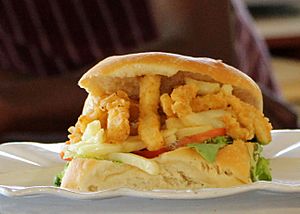
Where Can You Find Submarine Sandwiches?
Long rolls filled with food have been common in many European countries for over a hundred years. They were popular in places like France and Scotland.
In the United States, the sub started with Italian American workers in the Northeast. Over time, pizzerias began to offer them. As subs became more popular, small restaurants called hoagie shops or sub shops opened. These places specialized in making these sandwiches.
A food writer named John Mariani wrote that pizzerias were among the first Italian American places to eat. But even a long time ago, there was a clear difference between a pizza maker and a true restaurant. So, many pizzeria owners started offering other dishes, like the hero sandwich.
Subs or similar sandwiches were already popular in many countries around the world. Then, in the late 1900s, large chain restaurants like Subway made them even more famous. These chains helped the word "sub" become well-known everywhere. Many places now offer new and different combinations of ingredients for subs.
In the United States, there are many chain restaurants that specialize in subs. Some big international chains include Firehouse Subs, Quiznos, Mr. Sub, Jimmy John's, and Subway, which is the largest restaurant chain in the world. You can also often find these sandwiches in supermarkets, local delis, and convenience stores. Places like Wawa and Publix are known for their subs.
See also
 In Spanish: Sándwich submarino para niños
In Spanish: Sándwich submarino para niños


